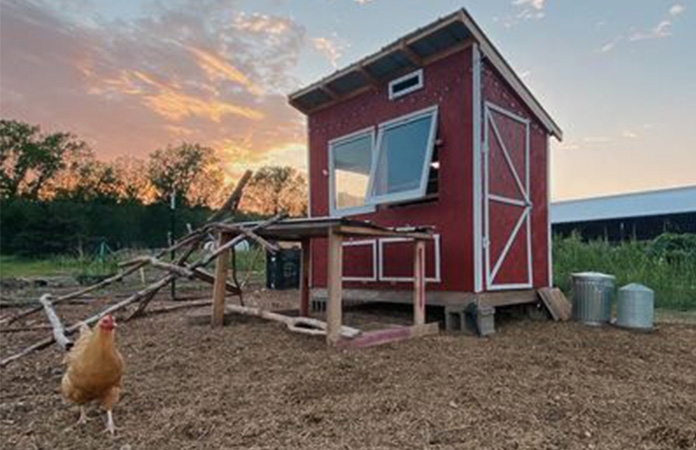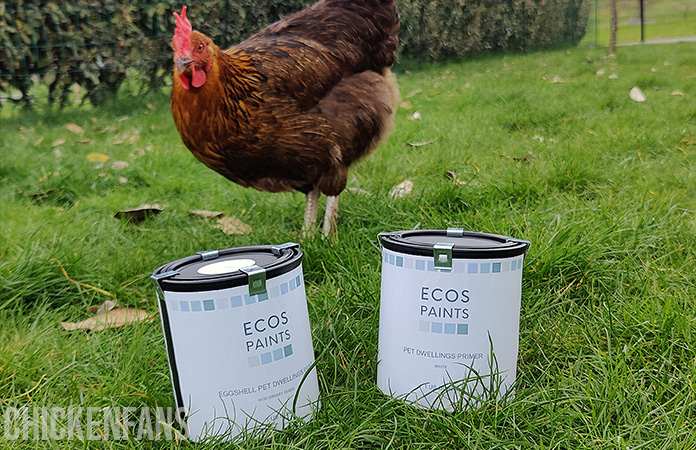Why Are Chicken Coops Red?

Ever wondered why chicken coops are mostly painted red? They’re often maroon with cute white accents on windows and shutters. It’s the go-to color combo for chicken owners, so much so that some manufacturers only make red and white coops. But why are these colors so cluckin’ popular? Let’s find out.
Chicken Coops as Mini Barns
Many chicken enthusiasts want their coops to look like charming mini red-and-white backyard barns. You got to give it to them: seeing the hens and roosters hop into their own little house in the yard is adorable.
The shades of red and white make great beauty shots with the exotic hens that backyard chicken keepers house these days. It creates an idyllic picture, ideal for Instagram.

Plenty of online articles state chickens are attracted to the color red; therefore, chicken owners paint their coops red. This was never proven, but the idea is undoubtedly widely spread. Because of this belief, chicken feeders, waterers, and coops are primarily sold in red. It’s the preference of the buyer/chicken keeper.
Chickens are not colorblind; they can see more colors than humans can. But their preference for specific colors isn’t determined, and chickens use their sensitivity to color like any other animal does: to find a partner (which often involves a colorful plumage) or eat colorful fruit (dangerous or not?).
So it’s not that giant Brahmas and Black Frizzle Cochins prefer a red-painted coop: it’s the people that own them that like the charming scenery of the miniature barn.
Homesteaders paint their coops red and use art stencils to paint the coop name on the wall.
All great, but this brings us to the following question:
Why Are Barns Red?
Red has always been a popular choice for barns. Many years ago, people didn’t have the luxury of picking up one of the many barn paints available on the store shelves. Farmers had to be creative to find paint that would protect and seal the wood of the barns and the chicken coops.
Most of them used a mixture based on linseed oil, a yellowish oil obtained from dried seeds of the flax plant. They added lime and rust to the mix, which gave the barns and coops their signature dark maroon look.
Rust kills fungi and mosses that grow in wooden barns’ crevices. It was an affordable way of keeping the barns clean, as rust was always available on the old farms. The linseed oil with red iron oxide quickly became a popular way to give the barn a protective layer that lasted for years.
Modern Red and White Coop Paint
When commercial paints became widespread, people stuck to the tradition of painting the barn red.
Nowadays, red barn paint and oils no longer contain rust but are produced with red color pigments, chemical adhesives, and additives. Although painting the coop is still a good idea to make the coop weatherproof and durable, you must take some precautions to select paint, stain, or oil safe for your birds.
If you plan to paint your coop, choose non-toxic, low-VOC oil or paint for the chicken coop. VOCs are Volatile Organic Compounds that are unhealthy for chickens and will irritate the chicken’s respiratory system. Luckily there are a lot of animal-friendly paints on the market, like Ecos Paints, that has no VOC.

While red is the most common color for the outside, many people choose plain white for the inside and some dark colors for the nesting boxes. Hens tend to like shady nesting boxes, and it seems to have a calming effect.
Why People Paint Their Chicken Coop Red
All things considered, here are some reasons why you see so many red-and-white chicken coops:
- The red color resembles the color patterns of traditional barns. Many people adhere to these traditions.
- Many farmers have leftovers from painting their barns, so they use the same paint for their coops.
- Red and White Barn paint is readily available on the shelves; it’s an affordable option that often comes with seasonal discounts.
- Some manufacturers only create chicken coops in red and white colors, so you can’t even buy other colors.
Is Red Chicken Coop Paint Effective Against Red Mites?
Some people believe painting the coop red keeps red mites out. This is partially true but has nothing to do with the coloring. Painting or staining the coop fills the tiny gaps in the rough wood and removes many hiding spots.
In fact, it’s best to paint the inside of the coop white. You will spot these little critters immediately when they crawl around on the glossy white surface of the coop.
Wrap Up
Most chicken coops are red because people like the sight of a miniature traditional red-and-white barn. Many years ago, farmers didn’t have red paint, so they used a mixture of linseed oil with red rust to paint their barns.
When paint became commercially available, people kept adhering to the tradition. When they finished painting their barns, they used the leftovers to paint the chicken coops.
Although it’s a common belief that chickens are attracted to red colors, scientific evidence does not support this. A chicken coop is red because the owners like it to be red, not because the chickens prefer red.






















